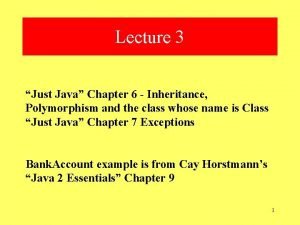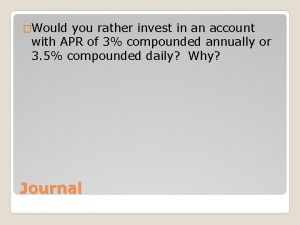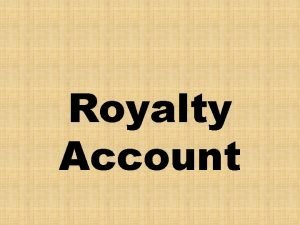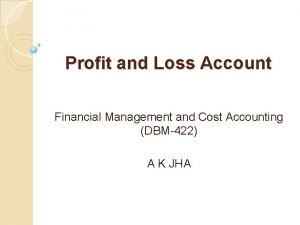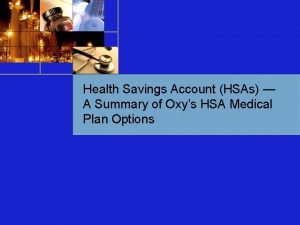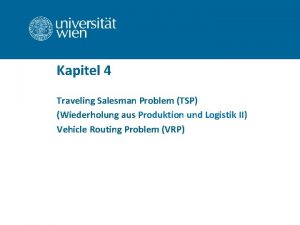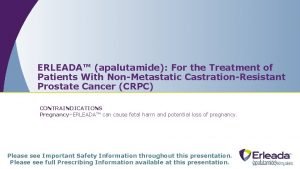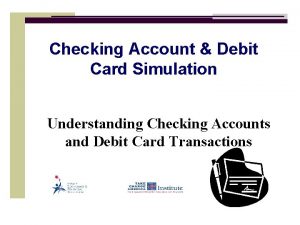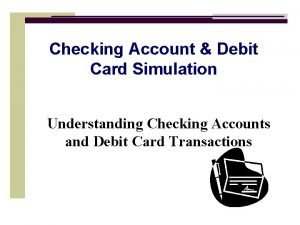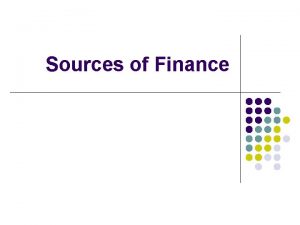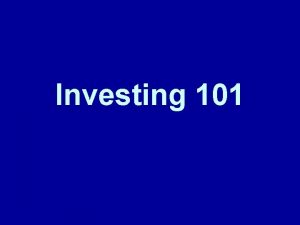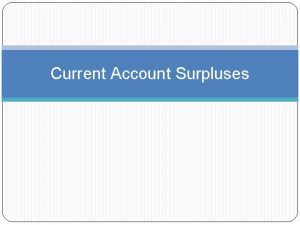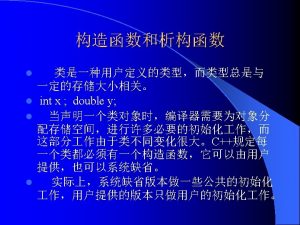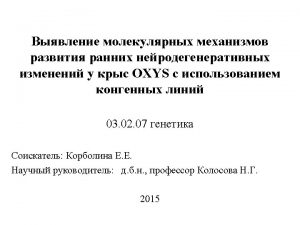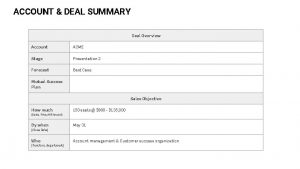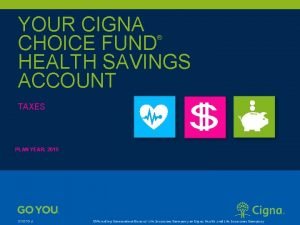Health Savings Account HSAs A Summary of Oxys







































- Slides: 39

Health Savings Account (HSAs) — A Summary of Oxy’s HSA Medical Plan Options

A Glimpse at Available Plans for 2007 • Basic POS ($300 deductible) plan remains. • HMO and other regional plans • Two high deductible Health. Fund plans with HSAs — the Health. Fund Plus and the Health. Fund Saver This presentation focuses on the Health. Fund options. 2

Definitions • • • EFT: EOB: FSA: HDHP: HMO: HSA: IRA: OOP: POS: Electronic Funds Transfer Explanation of Benefits Flexible Spending Account High Deductible Health Plan Health Maintenance Organization medical plan Health Savings Account Individual Retirement Account Out-of-Pocket maximum Point-of-Service medical plan 3

Contributions for the Aetna Medical Plans 2007 Plan Year Monthly Employee Contributions Employee Only Employee + 1 Family Basic POS $ 70 $140 $210 Health. Fund Plus $ 50 $100 $150 Health. Fund Saver $10 $20 $30 HSA Options 4

HSA Medical Plan Options • Two options with Health Savings Accounts (HSAs): – Health. Fund Plus – Health. Fund Saver • These options have both a medical plan and a savings account component. 5

Medical Component of Health. Fund Plans 6

POS Refresher: How Deductibles Work OOP Limit (includes deductible) Plan Pays You Pay You pay 100% up to deductible, then 10 -20% until your out-of-pocket limit, then Plan pays 100% Deductible 7

Deductibles • Basic POS: – $300 individual – $600 family • Health. Fund Plans: Employee Only Employee + One Family Health. Fund Plus $1, 250 $2, 500 Health. Fund Saver $2, 650 $5, 250 • Basic POS has a separate individual deductible for Employee + One and Family coverage. The Health. Fund plans do not. 8

OOP Maximums • Basic POS: Separate individual and family OOP maximums. • Health. Fund Plans: No individual OOP maximum. • Based on salary for all plans. • Remember, OOP max includes the deductible under all Aetna plans. Under the Health. Fund options, benefits are not payable for any one individual until the family deductible has been met. This means that if you enroll for Employee + One or Family coverage, your family must (1) meet the entire deductible before coinsurance applies and (2) meet the entire OOP max before the plan pays at 100%. 9

OOP Maxes (cont. ) Differences between Basic POS and Health. Fund options are highlighted in red. Health. Fund Plus/Health. Fund Saver Basic POS Individual OOP Max Employee Only OOP Max Annual Base Salary < $30, 000 - 39, 999 $40, 000 - 49, 999 $50, 000 - 59, 999 $60, 000 - 69, 999 $70, 000 - 79, 999 $80, 000 - 89, 999 $90, 000 - 99, 999 $100, 000 + Basic POS $1, 300 $1, 500 $2, 000 $2, 500 $3, 000 $3, 500 $4, 000 $4, 500 $5, 000 Health. Fund Plus Health. Fund Saver $1, 300 $2, 650 $1, 500 $2, 650 $2, 000 $2, 650 $2, 500 $2, 650 $3, 000 $3, 500 $4, 000 $4, 500 $5, 000 Family OOP Max Employee +1 / Family OOP Max Annual Base Salary < $30, 000 - 39, 999 $40, 000 - 49, 999 $50, 000 - 59, 999 $60, 000 - 69, 999 $70, 000 - 79, 999 $80, 000 - 89, 999 $90, 000 - 99, 999 $100, 000 + 10 Basic POS $2, 000 $2, 250 $3, 000 $3, 750 $4, 500 $5, 250 $6, 000 $6, 750 $7, 500 Health. Fund Plus Health. Fund Saver $2, 500 $5, 250 $3, 000 $5, 250 $3, 750 $5, 250 $4, 500 $5, 250 $6, 000 $6, 750 $7, 500

Medical Coverage for Health. Fund Plans vs. The Basic POS • What’s the same? – Health. Fund plans work like Aetna Basic POS plan with deductibles, coinsurance, and medical claim forms. – Same network: Aetna Open Access/Choice II POS. • What’s different about HSA plans? – No in-network lifetime benefit maximum. (Max under Basic POS is $3 million. ) – Most preventive services covered at 100%. 11

Preventive Coverage • Health. Fund Plans: 100% coverage before deductible for these in-network preventive services: – – – Colonoscopies Sigmoidoscopies PSA tests Mammograms Pap smears Well child care (to age 18) • Basic POS: 80% coverage after deductible, in network. Note: Subject to age and frequency schedule (posted on Oxy. Link). 12

Drug Coverage for Health. Fund Plans • Similar to drug coverage under Basic POS. • Differences: – Combined medical/drug deductible, per IRS rules. – You pay the full cost and must meet combined deductible before coinsurance applies. – No separate out-of-pocket maximum for drugs. – Provided through Aetna instead of Medco. (One ID card for medical and Rx!) 13

Savings Component of Health. Fund Plans 14

What is a Health Savings Account? • Tax-advantaged savings account that’s available only with a high deductible health plan. • New way of saving for health expenses and retirement. – Before age 65, use it tax-free for qualified health care expenses. – After age 65, still use it tax-free for health care, but also use it like an IRA for other expenses. • Like an IRA, only better! – Never taxed if used for medical expenses. – No income limits; employees at all salary levels may participate. – Pretax payroll deductions available. • The account is held at JPMorgan Chase. It’s yours, even if you change health plans or jobs. 15

You and/or Oxy Fund the Account • Annual contributions allowed up to the amount of your medical plan deductible every year. HSA Option Health. Fund Plus: Employee Only Employee + 1 & Family Health. Fund Saver: Employee Only Employee + 1 & Family Oxy Contribution Maximum Employee Contribution Maximum Combined Contribution $500 $1, 000 $750 $1, 500 $1, 250 $2, 500 None $2, 650 $5, 250 • Employee contributions to an HSA are optional. • Oxy pays the basic administrative fee while you are an active employee and enrolled in an Oxy Health. Fund; you pay when you disenroll, terminate or retire. 16

Oxy Contributions • Applies to Health. Fund Plus option. – Beginning in 2007, Oxy will make prorated contributions twice each month – You own the funds once deposited. • No Oxy contributions to Health. Fund Saver option, but significantly lower employee contributions for medical coverage. 17

Employee Contributions: Pretax • Payroll deduction made before federal and state taxes (in most states) are taken from paycheck. • Some states in which Oxy operates do not allow tax-free treatment of HSAs: Alabama, California, New Jersey, and Pennsylvania. • Maximum monthly contribution via payroll deduction is 1/12 of your annual limit. • Your contributions will be credited in your HSA twice per month. 18

Employee Contributions: After-Tax • Send directly to Aetna via check or electronic funds transfer (EFT) from your bank account. • “Above-the-line” deduction on tax return: – Reduces your taxable income by the amount of your after-tax contribution. – Do not have to itemize to claim deduction. • Contribute up to April 15 of the following year. • Your responsibility not to exceed maximum contribution limit. 19

Employee Contributions: Catch-Up • Catch-up contributions for age 55+. • Send directly to Aetna via check or electronic funds transfer (EFT) from your bank account. • Both employee & spouse may contribute. – Spouse must also be 55+ and covered under HDHP. – Separate account and application for spouse; separate fees also apply and will be deducted from account. • Up to $800 person in 2007; eventually $1, 000 by 2009. • Separate from catch-up contributions under Oxy’s Personal Savings Account (the PSA). • In addition to annual contribution limits shown earlier. 20

HSA Specifics • Unlike health care FSA: – No “use it or lose it” rule; funds roll over each year. – You cannot draw money that is not in the account. It’s like a bank account. • Tax free when spent on “qualified expenses. ” 21

Sample “Qualified Expenses” under HSA • • • Medical deductibles and coinsurance Diagnostic services Dental and orthodontia Routine physicals LASIK surgery, contact lenses and eyeglasses Non-covered prescriptions such as birth control pills, drugs for sexual dysfunction, plus most over-the-counter drugs Hearing aids Medicare and Medicare Advantage premiums COBRA premiums Qualified long-term care premiums Certain retiree medical premiums/contributions See IRS Publication 502 for details 22 Items in black may be reimbursed from Regular FSA or HSA. Items in red may only be reimbursed from HSA.

Accessing Your HSA Funds • Use Aetna HSA debit card or Aetna-issued checks at pharmacy, provider’s office or ATM to access HSA funds. – No fee to use debit card at provider’s office or pharmacy. Fee for use at ATM. – HSA checks available upon request. $10 for book of 25. • Process: – Pharmacies: You can use your VISA debit card at time of purchase. – Physician services: • Submit medical claim for network discounts and credit toward deductible. • Generally, network providers file medical claims on your behalf and will not require payment in advance. • Pay doctor’s bill after claim has been processed. – No claim forms to obtain reimbursement from HSA. 23

Accessing Your HSA Funds (cont. ) • You must have funds in your account to obtain reimbursement. • Keep all your receipts and documentation in case they are requested by the IRS. • Remember, you don’t have to use your HSA funds for current expenses. • Details are in your Aetna Welcome Kit. 24

Tax Advantages Trip le Tax Sav ings ! • Contributions tax free. • Investment earnings tax free. • Withdrawals tax free if used for qualified expenses. Notes: • If HSA funds are used for other than qualified medical expenses, the expenditure will be taxed and, for individuals who are not disabled or not over age 65, subject to a 10% penalty tax. • Some states in which Oxy operates do not allow tax-free treatment of HSAs. (See slide 18. ) 25

Investment Options • If account balance < $2, 000: – Interest-bearing, FDIC-insured account at JPMorgan Chase Bank. – Cash account earning 4. 11% as of September 2006. • If account balance > $2, 000: – Access to 8 JPMorgan mutual fund options: • 3 Asset Allocation funds • 2 Fixed Income funds • 2 US Equity funds • 1 International Equity fund – $2. 50/month investment fee applies if you invest in mutual funds. – Mutual funds are not FDIC-insured and expose investors to the risk of loss of principal, but provide the opportunity to earn higher returns than might be available in the HSA cash account. – More information is made available when your balance hits $2, 000. 26

HSA Fees es e F E: T O om r f N d cte ance. u d e l d a b t un o c c a 27

Why Would I Enroll? 28

Employee Example 29

Sample Employee Oxy Salary = $40 k, Family Coverage Claims shown on the bottom axis, employee’s expenses (including medical contributions) on the side. Lines show employee expenses at different claims levels. This graph shows that: Below ~$3 k in claims, this family has the lowest out-ofpocket expenses in the Health. Fund Saver plan. Above ~$3 k in claims, this family has the lowest out-ofpocket expenses in the Health. Fund Plus plan. Use the Plan Cost Estimator to choose the right plan for you. EE Spend = Oxy medical contributions + coinsurance/deductible – HSA seed 30

Sample Employee Oxy Salary = $75 k, Family Coverage Claims shown on the bottom axis, employee’s expenses (including medical contributions) on the side. Lines show employee expenses at different claims levels. This graph shows that: Below ~$3 k in claims, this family has the lowest out-ofpocket expenses in the Health. Fund Saver plan. Above ~$3 k in claims, this family has the lowest out-ofpocket expenses in the Health. Fund Plus plan. Use the Plan Cost Estimator to choose the right plan for you. EE Spend = Oxy medical contributions + coinsurance/deductible – HSA seed 31

HSA Pros/Cons PROS CONS • Tax advantages and interest/ investment earnings. • No “use it or lose it” rule. • Portable. • Most preventive services covered at 100%. • Unlike IRAs, no income limits. • Additional complexity. • Higher deductible. • Limited purpose FSA (discussed on slide 34). • Risk of principal loss in optional mutual fund investments. • Employees have more ownership/accountability. • Incentive to constrain unnecessary utilization. 32

What Else Do I Need to Know? 33

“Limited Purpose” FSA • If you enroll in an HSA and a health care FSA, the FSA must be a “Limited Purpose” FSA • Before you meet the combined medical/drug deductible, the only things you may reimburse from your Limited Purpose FSA are expenses for: – Dental – Vision – Certain preventive care drugs and services • After meeting the deductible, you may use your Limited Purpose FSA for all qualified health care expenses. • “Use it or lose it” rule still applies. • Consider maximizing contribution to HSA before contributing to Limited Purpose FSA. 34

Who Can Enroll? • To enroll in an HSA, you must: – Be covered by a High Deductible Health Plan (HDHP), as defined by IRS. (Both of Oxy’s Health. Fund plans meet the requirements. ) – Not be covered by another health plan (e. g. , your spouse’s medical plan) that is not a high deductible health plan and/or FSA plan. 35

Spouses with Medical/FSA Coverage If your spouse has a: Allowable Participation Under Oxy’s Health. Funds/HSAs Non-HDHP Medical Plan (including Medicare) If you are covered under your spouse’s medical plan, you and your eligible dependents may enroll in an Oxy Health. Fund plan but not in a Health Savings Account. If you are not covered under your spouse’s medical plan, you and your eligible dependents may enroll in an Oxy Health. Fund plan and in a Health Savings Account. Your HSA contribution limit is based on your coverage level deductible under your Health. Fund plan. Regular Flexible You and your eligible dependents may enroll in an Oxy Health. Fund plan but not in Spending Account (FSA) a Health Savings Account for Health Care Note: This chart is not intended to be all-inclusive or to address unique circumstances. Seek guidance from a qualified tax advisor as needed. 36

Can I Take the HDHP Without the HSA? • You may enroll in an Oxy Health. Fund plan and decide: – Not to make a contribution to an HSA. – To make a contribution to an HSA account with another insurer or financial institution. 37

What Else? • Prescription drug issues: – Refill information will not pass from Medco to Aetna. – Get new prescriptions to set up mail order with Aetna. • If you terminate, retire, or disenroll from an Oxy Health. Fund plan, you keep the HSA but you must pay the basic account administrative fee. • Aetna/JPMorgan Chase will send the necessary tax forms showing your prior year’s contributions & withdrawals. • Aetna will send a Welcome Kit with more information to enrollees. 38

The Small Print The company expects and intends to continue its benefit plans but does not guarantee any specific level of benefits or the continuation of any benefits during any periods of active employment, inactive employment, disability or retirement. Benefits are provided solely at the company's discretion and do not create a contract of employment. The company reserves the right to modify, suspend or terminate any of its plans at any time. This information is applicable to eligible nonrepresented employees. Applicability to represented employees is governed by local collective bargaining agreements. Subject to this and future agreements, the company reserves the right to change, amend or terminate any benefit plan at any time. The information provided in this document is NOT tax advice. While the information is believed to be accurate as of the print date, it is subject to change. Consult a qualified tax expert for advice on determining eligibility for any tax benefit mentioned herein. 39
 Bny mellon health savings account
Bny mellon health savings account Account rule
Account rule Savings account java
Savings account java Bank account java program using inheritance
Bank account java program using inheritance Sally invests £8000 in a savings account
Sally invests £8000 in a savings account Sales account title
Sales account title Royalty account analytical table
Royalty account analytical table 3 errors that affect the trial balance
3 errors that affect the trial balance Diff between trading account and profit and loss account
Diff between trading account and profit and loss account Firsthand and secondhand accounts
Firsthand and secondhand accounts Health account
Health account Pengertian inflasi biaya kesehatan
Pengertian inflasi biaya kesehatan Health account
Health account Health account
Health account Geothermal cost savings
Geothermal cost savings Texas 529 plan
Texas 529 plan How to calculate annuity
How to calculate annuity 2 opt verfahren
2 opt verfahren Icici savings suraksha
Icici savings suraksha Retirement savings percentile
Retirement savings percentile 3 tier banking system
3 tier banking system Il 529 bright directions
Il 529 bright directions A measurable savings goal spells out ________.
A measurable savings goal spells out ________. Welcome to grade 12
Welcome to grade 12 Janssen carepath savings program
Janssen carepath savings program Alberto musalem
Alberto musalem Chapter 5 savings accounts
Chapter 5 savings accounts Budgeting and savings
Budgeting and savings Icici pru savings suraksha
Icici pru savings suraksha Savings tools definition
Savings tools definition 2-3 savings accounts answers
2-3 savings accounts answers Get vs dreamahead
Get vs dreamahead 529 plan montana
529 plan montana 3-1 checking accounts worksheet answers
3-1 checking accounts worksheet answers 3-1 checking accounts worksheet answers
3-1 checking accounts worksheet answers Disadvantages of rsa retail savings bonds
Disadvantages of rsa retail savings bonds Asset liabilities equity
Asset liabilities equity Savings and loan associations
Savings and loan associations Types of cost savings
Types of cost savings Advantages of savings
Advantages of savings



